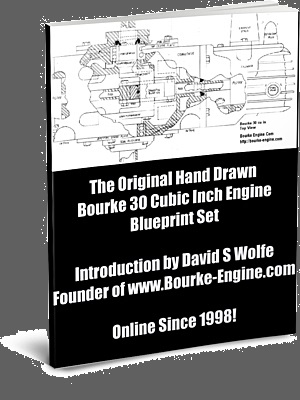Bourke 30 Specifications
As claimed by Russell Bourke, Inventor
- Normally aspirated, carburetor or fuel injected
- Highly efficient exhaust scavenging
- High pressure pre-charge from underneath piston to combustion chamber during transfer cycle
- True linear movement
- Free piston engine
- No angularity of moving parts.
- No piston side loading
- Cylinders sealed off from crankcase
- Horizontally opposed twin cylinder, common plane
- Mono stroke, i.e. two directly opposed 2 stroke cylinders connected through one common/linear rod/yoke assembly
- Two 135 degree power pulses per revolution
- Valving: ported
- Balanced precision reverse cam effect roller crankshaft
- High horsepower to weight ratio
- 30 cubic inch 2 cylinder Bourke cycle engine
- Constant RPM stationary power plant
- Potential adiabatic operation at specific RPM range
- Test fuel: low octane gasoline, coleman and 1-K
- Weight: +/- 38 pounds.
- Aluminum crankcase, cylinder castings and pistons.
- Steel cylinder liners, connecting rods, yoke plates, camshaft, wrist pins, bearings
- 35 hp or more at 5,000 RPM
- Estimated up to 5 HP per cubic inch
- Fuel consumption: 1/4 pound or less of fuel per horsepower hour
- Carburetor or fuel injection
- High RPM ignition system
- Multi fuel capable, i.e. natural gas, propane, low octane fuels
- Tested fuels: gasoline, bio diesel, fuel oils, white gas, 1-K
- Other fuel tpes not yet tested
- Exhaust gas temperature: 190° to 240° F!
- Exhaust gas components resulting from regular no lead gasoline: carbon dioxide and water vapor
- Emission: much lower than normal PPM HC burning regular no-lead fuel
- Compression ratio: 8:1 to 20:1
- Fuel air ratio: 30:1 to 50:1
- Exhaust system: lightweight baffled aluminum housings
- Liquid or air cooled
- Lubrication system: internal splash/vacuum type oiling
- Ignition system: electronic capacitive discharge
- Self sustaining pressure ignition for diesel applications
|
BENEFITS:
Could be used to power generators, pumps, hybrid cars, boats, ultra-light aircraft, and many others! Your
imagination is your only limit. Best use tested so far is constant duty applications.
- Highly fuel efficient
- Environmentally friendly
- Multiple fuel capable
- High HP to weight ratio
- Capable of safe constant duty operation
- Very low fuel consumption
- No emission control devices needed
- Simple construction
- Very low maintenance
- Easy overhaul
- No oil changes needed
|





|